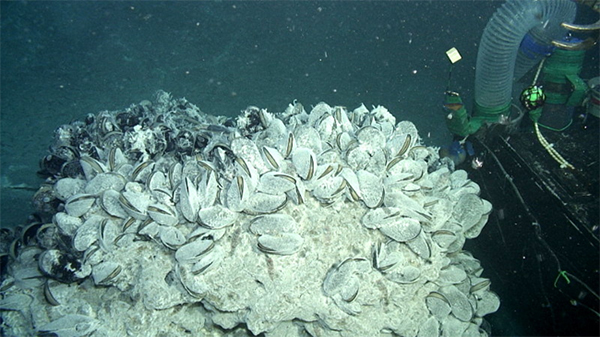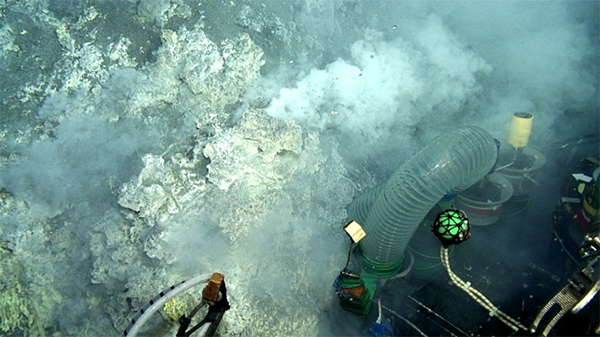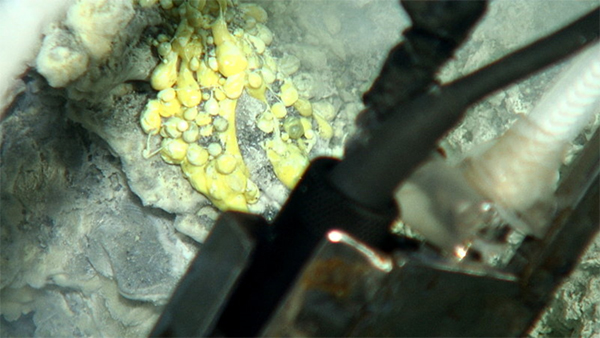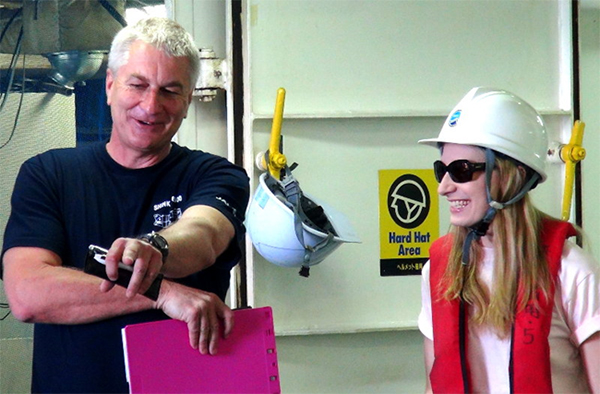QUELLEレポート
Hinepuia volcano-the god of geothermal activity is alive and well
2013/10/30
Cornel de Ronde(GNS)
10月30日、Hinepuia海底火山への潜航を実施!
とうとう最後の潜航となりました。潜航者はウエリントンにあるGNS(ニュージーランドの地質調査機関)のDr. Cornel E.J. de Rondeさんです。
博士は、首席科学者として世界中の海底火山に関連する海底の鉱物資源の研究を行うチームを率いています。ケルマディック島弧の多くの調査をこれまで行ってきました。最近のHinepuia火山の調査は2004年に行っています。18年前には、日本のつくば市にある地質調査所(当時)に3年間招聘研究者として滞在しています。その間に「しんかい2000」で沖縄トラフに潜航を経験されたとのことです。また合気道の初段を滞在中に取得したそうです。日本のことをよくご存知で、とても親しみやすいお人柄です。今回は念願の噴出孔を発見し興奮さめやらぬ博士から、とれたての潜航レポートをお送りします。
Hinepuia is Maori for guardian god of geothermal activity. After today’s dive on the volcano, SHINKAI 6500 pilot Iijima-san, co-pilot Katagiri-san and myself can attest that she is as active as ever! What an incredible dive we had, to a place that is not that far to get to, but felt like was on a different planet such were the scenes that awaited us. Indeed, we set a record for depth in our dive with the SHINKAI 6500, a record shallow depth with the summit of the volcano at 304 m! The whole dive only covered a depth range of 192 m from the landing point at 496 m to the summit. But as is common with submarine volcanoes and associated hydrothermal activity, big things can occur over small depth intervals.
The dive began with us landing, finding our bearings, then sampling animals, rocks and sediments nearby, before heading upslope to where we hoped the vent field would be. Back in 2004, during the NZAPLUME III cruise, we had surveyed Hinepuia volcano with a CTDO (conductivity-temperature-depth-optical) package towed behind the ship, winching it up and down in a saw-tooth pattern, looking for the 'smoke' that invariably occurs with venting of hot water on the seafloor. Here, the hydrothermal fluid mixes with seawater resulting in the previously dissolved metals precipitating out as tiny particulates, and thus producing great billowing plumes of smoke. Hence the name 'black smokers'. Results from the CTDO survey of Hinepuia showed there was intense hydrothermal activity occurring atop a cone inside a larger caldera. And it all occurred between ~400 and 300 m with the strongest plumes around 350 m. We also knew that plumes don’t rise very much in shallow water, so our plan was to search the cone on its southern side along the 400 m contour. Easier said than done with the very limited visibility from the submersible. But we had a plan.
We acended up the flank of the cone to the summit, noting an abundance of coral with distinct yellow polyps on the way. We saw large shoals of fish, several large sharks and one large octopus. But no sign of hydrothermal activity, much to my surprise. So, we went back to the plan and descended to 400 m and started driving westwards along the 400 m contour. First, we saw numerous chutes of debris cascading down the slopes adjacent to outcrops of massive, locally blocky and sometimes flow banded lava. Then, we saw a few shells of dead clams and mussels. Always a good sign in the hunt for hydrothermal activity, as these animals invariably live near the vents. Next, we came across several large piles of dead shellfish, with trails of shells heading back up the slope. This was the sign we were looking for. SHINKAI 6500 followed the trail and bingo, at the top of the slope (337 m) was a ridge which was completely covered in a fine white dust, almost certainly sulfur. Numerous small holes pockmarked the surface of the sediment with bubbles streaming from them. Carbon dioxide. Then, once our eyes focused, we realized that the entire surface was completely covered by small flatfish. I had seen this once before, at Dikoku volcano of the Mariana arc, and to a lesser degree Giggenbach volcano of the southern Kermadec arc. But here we were on Hinepuia volcano, 500 km further north. They sure get around.
But there was more to come. Much more. We surveyed the area and noted that nearby outcropping rocks were completely covered by squat, black mussels that I have also seen at Giggenbach and Macauley volcanoes, similarly rich in sulfur and which also occur at shallow sites. After another round of sampling animals, measuring temperatures and so on, it was time to try and find the source of what had to be vigorous hydrothermal venting. But we were close, as a waft of smoke just drifted across our path. We followed the trial of smoke and went over the ridge and slowly descending down the other side. What greeted us was familiar, yet unexpected. We found our source, as huge thick clouds of smoke rose from the seafloor below us, but they were not black. They were white, and closer to the seafloor they were yellow! Sulfur-rich plumes, just like those at the presently erupting NW Rota-1 volcano of the Mariana arc. Were we descending on to an erupting vent? Not a good place to be in a submarine. Down we went, meter by meter until we were at the bottom, with the depth reading 372 m. They were right were they should be. We called it the "Iou" (Japanese for "sulfur") vent field.
Here was a world very different to that we normally equate to shallow seamounts. It is harsh with thick layers of sulfur, choking plumes of sulfur-rich smoke and the entire area dusted by sulfur particles. The rocks showed tell tale signs of having been etched by acid fluids. But this is an increasingly familiar sight on hydrothermally active volcanoes along arcs, especially those recently (or still) volcanically active. Time was ticking by, but now we had a problem. The currents were quite strong at these shallow depths, and we were continually being enveloped by thick plumes, with visibility down to zero. We caught a break with the plumes lifting for a few minutes, and managed to sample the vent fluids as they spewed white, yellow and some slightly blackish plumes from the same area. Just to prove how active volcano this volcano was, liquid sulfur suddenly started squirted out from some of the highly altered rocks nearby, forming spaghetti-like ribbons on the rock face. No doubt reservoirs of liquid sulfur were just below where the sub was sitting.
It was time to go. It had been an exhilarating experience, full of surprise, wonder, amazement and respect for this planet of ours, with Hinepuia still actively keeping watch on these brooding volcanoes and all their activity. But it was hard work, with the temperature inside the sub up to 30°C when normally much cooler (as we were working in such shallow depths) and the pressure was on to find the vents on our last dive of the expedition. We returned exhausted, but happy. How often to you get to so close to Hinepuia?
(仮訳)
"Hinepuia"とは、マオリの言葉で地熱の守護神(女神だそうです)を意味します。今回の「しんかい6500」の潜航で、彼女(Hinepuia火山)はこれまでどおり活発だった!というのが、パイロットの飯嶋さんとパイロット補佐の片桐さんと私の感想です。そこに行くにはさして時間はかからなかったけれども、我々を待っていた風景はまるで別の惑星のようで、そんな場所へ潜航したのは大変感動的でした。
実際、我々は、304m!という火山の頂上の深度、「しんかい6500」の最も浅い潜航記録を樹立しました。潜航を通じて、深さ496mの着底場所から192mの範囲で潜航しました。海底火山とその熱水活動の調査にはよくあることですが,この短い距離の間でも大きな発見が起こったのでした。
潜航はまず着底をし、そして方位を確認しました。それから、熱水噴出域があると期待している斜面に向かう途中で、動物、岩石及び堆積物を採取しました。2004年の「NZAPLUME III」航海で、我々はHinepuia火山について、海底で熱水が常に噴出している"スモーク"を見つけるため、CTDO(伝導度・温度・深度・光)の計測機船から曳航し、鋸の歯のようなジグザグ状のパターンで上げ下げして計測する調査を実施しました。
この火山では、熱水が海水と混ざると、それまで溶け込んでいた金属が微粒子として沈殿し、黒色の噴煙となって立ち上るわけです。そのため"ブラック・スモーカー"と呼ばれます。HinepuiaのCTDO調査の結果、大きなカルデラの中にある円錐状の地形(コーン)の上で強い熱水活動が起こっていることがわかりました。300〜400mの深度でプルーム(噴煙の拡散したもの)が発生しており、約350m深度が最強でした。我々は、さらにこのプリュームはとても浅いところでは起こらないことを知っていたので、400mの等高線にそってコーンの南側を調べることにしました。潜水艇からの視界は限られており、言うは易し行うは難しですが、我々は準備された計画がありました。
我々はコーンの側面を頂上まで上りましたが、その途中、黄色いポリプを備えたサンゴ(キサンゴ類)をたくさん見ました。我々は魚の大群や、いくつかの大きなサメ、一匹の大きなタコを見ました。しかしながら、とても驚いたことには,そこには熱水活動の気配がありませんでした。そこで、我々は計画に従い、水深400mまで下りて、等高線に従い西方向に航走を開始しました。最初に、我々は、大きく、ところどころ塊状になったり、流れの跡のついた溶岩の路頭近くの斜面を崩れ落ちたガレキを見ました。さらに、いくつか死んだ貝、ヒバリガイ(二枚貝の一種)を見ました。これらの動物はたいてい噴出孔の近くに住んでいるので、熱水活動を示唆するよい兆候です。次に、我々は斜面に続く、いくつかの大きな貝の死骸群に出くわしました。これこそ探していた痕跡です。「しんかい6500」は痕跡をたどりました。そして大当たり!!。イオウからなるこまかな白いちり状の物質で覆われた尾根が斜面の上(深度337m地点)にありました。数え切れない小さな穴が堆積物の表面にあり、そこから泡が出ていました。二酸化炭素です。それから、目を凝らすと、表面がたくさんの小さなカレイ類(アズマガレイ属の一種)で覆われていることがわかりました。かつて、私は、マリアナ島弧のDaikoku火山で同様の、そして、南ケルマディック島弧のGiggenbach火山でもやや同じような状況を見たことがあります。しかし、ここHinepuia火山は、そこから500kmも離れているのです。それらが、ここに存在していたのです。
さらに面白いことがわかりました。我々は、その一帯を調べ、近くの露岩が完全に、黒いシンカイヒバリガイと黄色の硫黄で覆われていたのです。シンカイヒバリガイ類は,同じように硫化水素に富み,しかも浅い場所に位置する GiggenbachやMacauley火山の熱水噴出域でも見られます。さらに動物採取、温度計測などを行ったあと、活発な熱水活動の源を見つけることに挑戦です。我々の行先を煙がおおっていることから、我々は、煙を追って尾根を超え、ゆっくりと反対側に下りていきました。待っていたのは、これまでなじみのあるものですが、一方で予想外のものでした。
我々の下方から大きな煙の濃い雲が立ち上っています。そして,その煙のもとを見つけました。しかし、その煙は黒くはありませんでした。白かったのです。そして海底にいくにしたがい黄色くなるのでした! イオウをふんだんに含むプルームです。現在噴火しているマリアナ島弧のNW Rota-1 火山のものにそっくりでした。熱水を吹き上げている噴出域に向かって降下したと思いますか?潜航艇の中にとどまるには厳しい場所です。我々は、1mごとにゆっくりと下りて深度372mの海底に到達しました。あるべきところにそれ、つまり噴出孔はあったのです。"我々はそこをIOU"(日本語のイオウ)ベントと名づけました。
ここは、通常の浅いところにある海底火山とは大きく異なる世界でした。そこは、ぶ厚い硫黄の層,吹き上がる濁水のプルーム,そして至る場所が硫黄の粒子で覆われた厳しい場所です。岩石は、酸性の流体によって腐食されたと考えられました。しかし、これは、島弧の熱水活動の活発な火山、特に最近(あるいは現在でもつづく)火山活動が活発だったところでよく見られるものです。時間は刻一刻と進む一方で問題がありました。この浅い深度では海流がきわめて強く、濃いプルームに包まれつづけ、視界が全くなかったのです。
煙が数分間上に向かうチャンスを利用し、同じ区域から吐き出される白色、黄色の、そして時にはやや黒みがかかる噴出孔の海水をなんとか採取しました。すっかり(色が)変わってしまった近くの岩から突然、流体のイオウが噴出し始め、岩石の表面をスパゲッティのようなリボン状に流れているなど、この火山がいかに活発であるかを物語っています。もはや、この潜水艇の真下に、液状の硫黄だまりがあることは疑う余地はありません。
帰る時間がやってきました。とても興奮しました。それは我々の住むこの惑星への驚異と敬意に満ちたものでした。Hinepuia(女神)は今なお、これらの怒りをかかえた火山とその活動を見守っているのです。それにしても大変な仕事でした。通常ですともっと寒いはずですが、浅い深度ですので(耐圧殻の)中の温度は30℃まで上がりました。この調査での最後の潜航で噴出孔を見つけねばならないというプレッシャーもありました。疲れましたがとても幸せです。Hinepuiaへの挑戦には困難は多くありましたが、なんでもやればできるということを教えてくれました。

写真1 見つかったシンカイヒバリガイ類

写真2 IOU(イオウ)と名付けられたフィールド(噴出域)の典型的な噴出孔

写真3 岩石の表面を流れるイオウ流体

写真4 ヴァレリーさん(GNSでコーネルさんの研究チームに所属)と潜航直前に談笑するコーネルさん(うしろの掲示はヘルメット着用のサイン (Hard Hat Area))